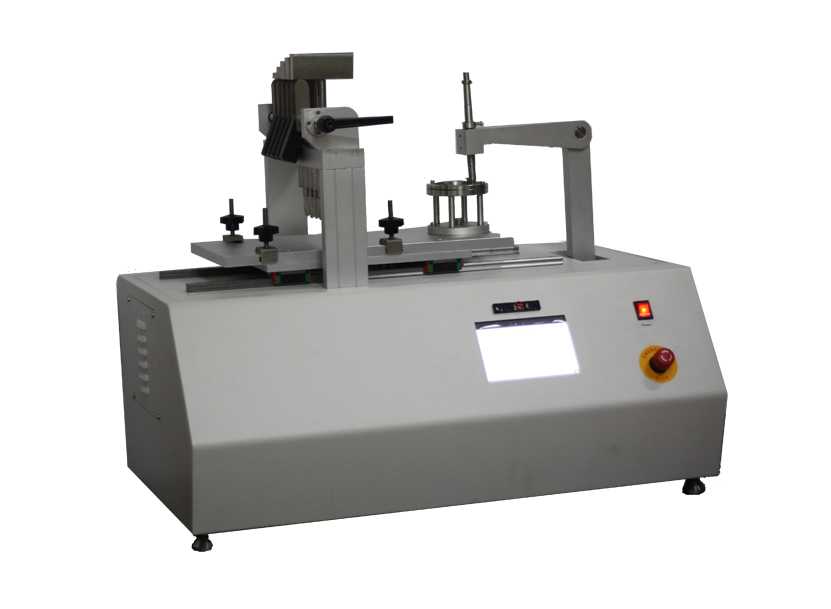Site: Home > News and events 
QINSUN instruments always been committed to innovation and improve product performance and functionality, we have our own textile testing laboratory. Our textile testing equipment and testing methods are in the leading position in the industry and have passed the textile testing certification and iso textile testing standards issued by a number of testing.
Introduction of several methods of leather abrasion resistance test
For leather abrasion resistance test methods, there are currently three test methods: STROLL abrasion method, TABER abrasion method and Martindale abrasion method, etc. As a professional Rotary Rubbing Color Fastness Testing Machine manufacturer, QIUSUN instrument will give you a detailed introduction These 3 methods!
1. Martindale abrasion method
The Martindale abrasion method is often used for the abrasion resistance test and evaluation of pilling of textiles. The Martindale abrasion method is used to rub samples with standard rubbing fabrics under constant pressure. The relative movement of the Li Sharu pattern between the rubbing fabric and the sample produces friction in all directions. After completing the specified number of frictions, evaluate the degree of damage to the sample.
During operation, place a piece of polyurethane foam with a thickness of (3±1)mm and a density of (30±3)kg/m3 on the back of the sample, and fix the sample on the grinding head with a clamp ring, and then set the table felt Place it on the grinding table, then place the friction fabric on the table felt, and place the weight that generates (2±0.2) kPa pressure on the friction fabric, and then fix the friction fabric. Finally, install the grinding head on the wear tester, apply a pressure of (12±0.2) kPa to the grinding head, start the instrument, and perform the test according to the number of rotations set by the counter. After the test, remove the sample, check and record the wear condition of the sample, and use the gray sample card to evaluate the color change in the test area according to GB/T 250-2008 "Textile color fastness test-gray sample card for evaluating discoloration".
2.STROLL abrasion resistance method
According to ASTM D 3886-1999 "Standard testmethod for abrasion resistance of textile fabrics (inflated diaphragm apparatus)", the test principle of the STROLL abrasion resistance method is to place the test sample on an inflatable rubber diaphragm with a constant air pressure and use it with specified surface characteristics Use sandpaper to rub the sample. After the specified number of rubbings, the degree of wear of the sample is evaluated by appearance.
Operation steps: Place the sample on the rubber film in a flat state, then place the sandpaper on the abrasive plate, and make the contact head connected with the sandpaper flush with the surface of the sandpaper. Then apply 28 kPa of air pressure under the diaphragm and 454 g of pressure above the abrasive plate, and ensure that the air pressure control and the contact between the inflated sample and the loaded sandpaper are in a stable and balanced state. Start the instrument and perform the test according to the number of revolutions set by the counter. After the test, remove the sample, check and record the wear condition of the sample, and use the gray sample card to evaluate the color change in the test area according to GB/T 250-2008 "Textile color fastness test-gray sample card for evaluating discoloration".
3. TABER wear-resistant method
American Standard ASTM D 3884-2009 "Standard test method for abrasion resistance of textile fabrics (TABER apparatus)" stipulates the TABER abrasion method. The test principle of the TABER abrasion method is: the test sample is placed on a rotating platform, and the two rolling friction wheels above it perform rotating friction movement with the sample under a certain load to wear the sample. One friction wheel faces outward, and the other friction wheel faces inward to rub the sample, forming a circular wear mark. After the specified number of rubbings, the degree of wear of the sample is evaluated by appearance.
Operation process: Fix the sample face up on the rotating platform, and install the selected grinding wheel on the supporting rod. After selecting a suitable load, lower the support rod to make the grinding wheel contact the surface of the sample, connect and open the dust suction device. Start the instrument and perform the test according to the number of revolutions set by the counter. After the test, remove the sample, check and record the wear of the sample.
QINSUN instruments always been committed to innovation and improve product performance and functionality, we have our own textile testing laboratory. Our textile testing equipment and testing methods are in the leading position in the industry and have passed the textile testing certification and iso textile testing standards issued by a number of testing.
2021-08-02 14:39
- Related News
What is the difference between conical and parallel twin-screw extruders?
What is the ISO standard for color fastness?
What is the use of a roundness tester?
The Role of Dust-Proof Robot Protective Clothing
What is the difference between Taber and Martindale abrasion tests?
The Role of Acid- and Alkali-Resistant Protective Clothing in the Chemical Indus
What is the difference between a capillary rheometer and a rotational rheometer?
What is the ASTM standard for abrasion testing?
ISO 105 X12 Colorfastness to Rubbing Test Guide
Working Principle and Standards of the Martindale Abrasion Tester

